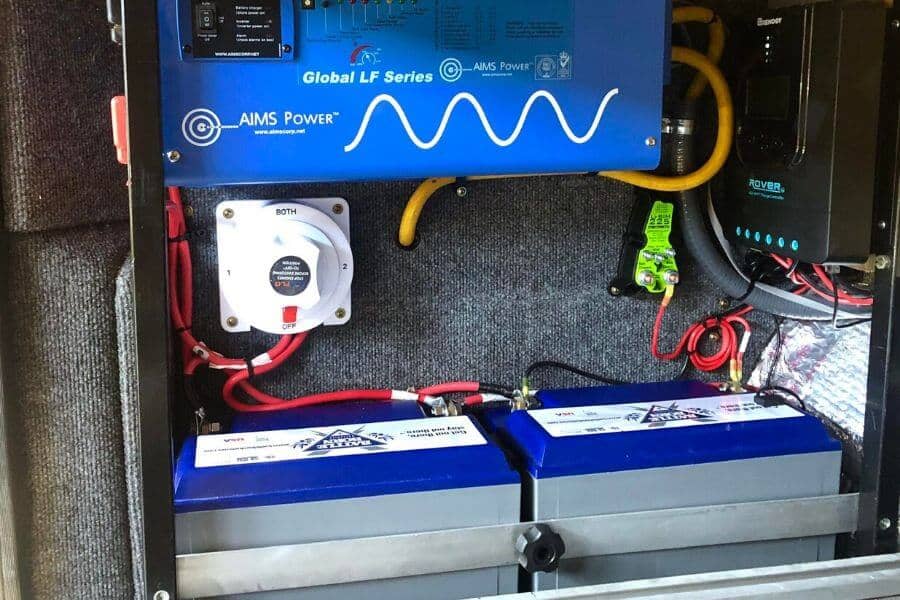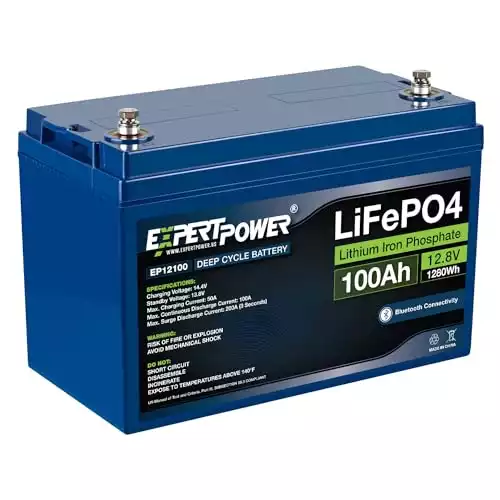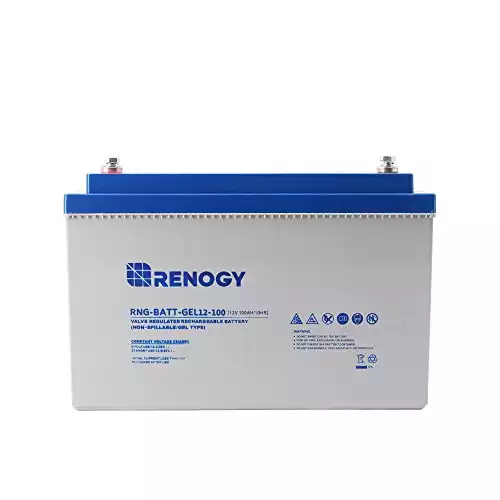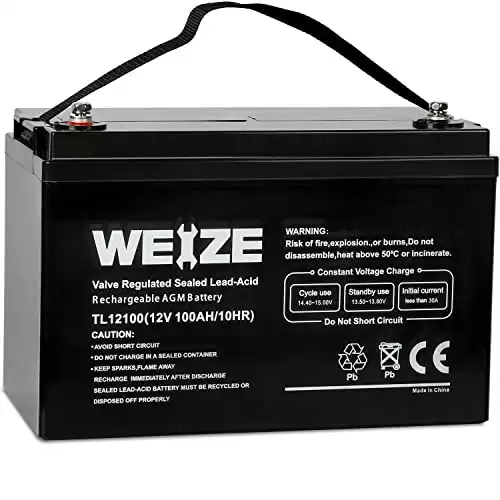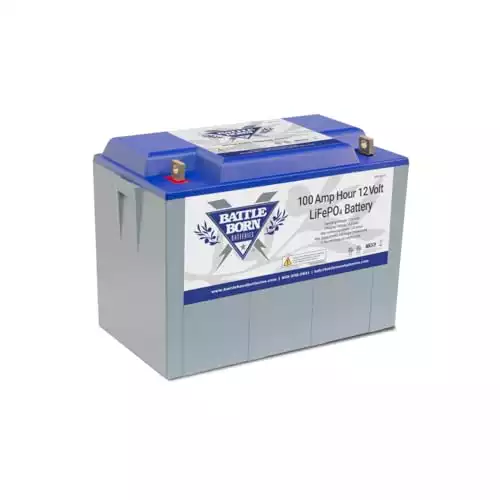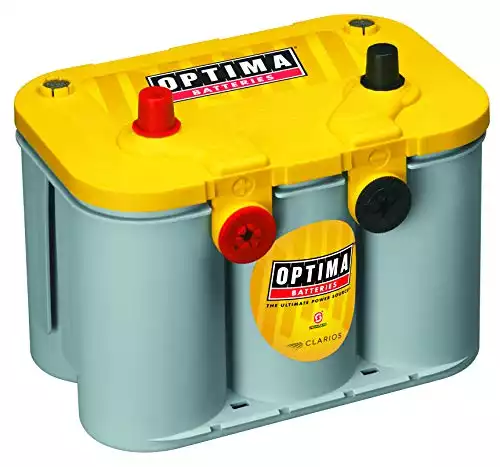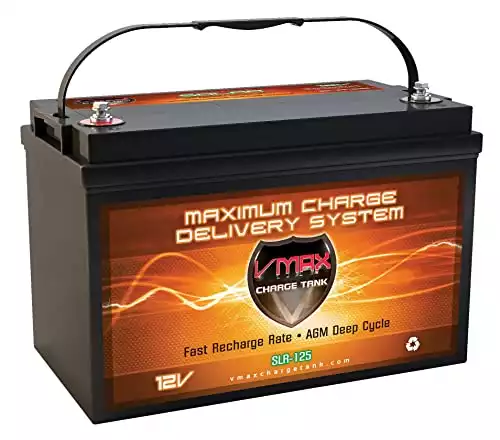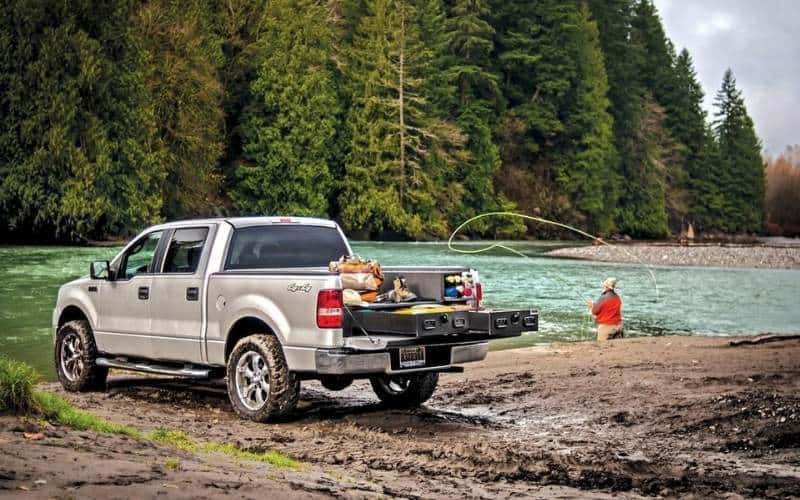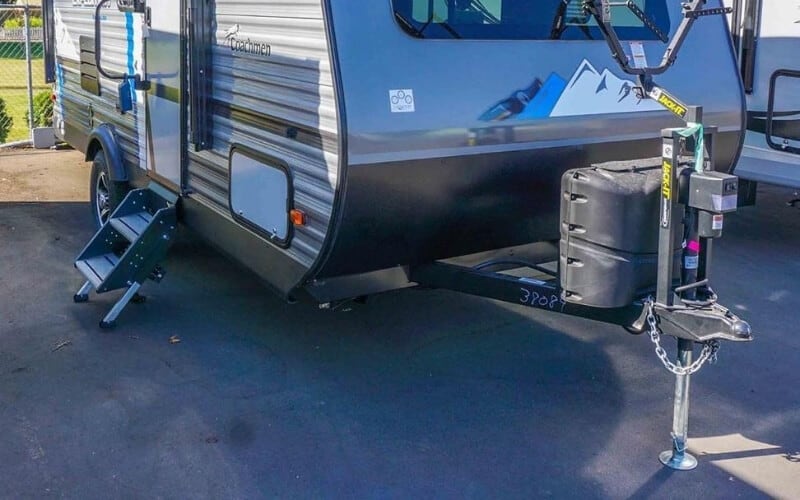Range anxiety typically involves the specific fear of running out of battery while you are camping off-grid without hookups.
RV batteries aren’t always created equal. If you’re boondocking, you’re going to need a long lasting battery that can keep all of your essential systems running for days at a time.
Otherwise, you risk being in an awesome remote camping location without power.
The best RV battery for boondocking will not just last a long time. It will also generate enough power to run all of your appliances smoothly, without tripping breakers and causing unnecessary headaches.
In this article, we’re going to present the 6 RV batteries that are best suited for dry camping and boondocking.
We’ll also present a comprehensive buying guide that includes tips on selecting the types of batteries when Boondocking, or dry camping and provides answers to some of the most frequently asked questions about RV batteries to experience even better if you prepare for boondocking.
At A Glance: Our Top Picks For Best RV Batteries for Boondocking in 2024
6 Best RV Battery For Boondocking Or Dry Camping 2024
‘Boondocking’ is defined as RV camping without connections to water, sewer, electricity, and cable.
Some folks also call it ‘dry camping’, ‘free camping’, or ‘wild camping’. When you’re living off-the-grid for days or weeks in a row, you’re going to want a battery that you can trust.
1: Best Overall: ExpertPower Lithium 12V 100Ah Deep Cycle Battery
The LiFePO4 is the newest in ExpertPower’s long line of batteries from the #1 seller of lead acid batteries on Amazon.
It boasts a longer service life than most lead acid batteries. This battery provides power for 2500 to 7000 cycles and has a total lifetime of 10 years.
Compare that to 200 to 500 cycles and a three-year lifetime for most batteries with lead acid chemistry.
This battery also delivers extremely efficient power. It has a flat discharge curve that can hold above 12 volts for up to 90% of its capacity usage.
This serves to astronomically boost run-time when you compare the average figure of 50% for most lead acid batteries.
This is also an extremely lightweight battery. It weighs just one-third of the weight of lead acid, which makes LiFePO4 the best overall RV battery for boondocking because it mobility is going to be one of the most important considerations.
This Rechargeable Battery also features a built-in Battery Management System (BMS).
This system protects the battery from overcharge, deep discharge, overloading, overheating, and short circuiting.
It also keeps the battery’s self-discharge rate extremely low in order to ensure up to one year of maintenance-free storage.
This battery should be used in climates with temperatures above 32 degrees Fahrenheit.
If used in places with temperatures that consistently dip below freezing, this battery should be used with solar controllers and temperature sensors that support low temperature cut-off.
Things We Like
Things We Don’t Like
2: Best Deep Cycle: Renogy Pure Gel 12V 200Ah Battery
If you’re looking for a deep cycle battery that can withstand the rigors of harsh environments, the Renogy Pure Gel Battery is a great choice.
This battery has some important security measures in place that will keep it running in wet, hot, and even sandy environments.
Renogy Pure Gel Battery features triplex sealed construction, which is valve regulated and triple strengthened around the battery terminals.
This construction prevents electrolyte leakage and guarantees the airtight and liquid state of the battery in normal operating conditions. It also prevents external air from entering the inside of the battery.
This battery also offers a long service life due to its heavy-duty, lead-calcium grids that ensure mild corrosion and allow for up to 10 years of standby use under optimal floating charge conditions.
This battery should also be operated below its optimal operating temperature of 25 degrees Celsius.
All Renogy batteries are also equipped with PE compound separator construction. This means that the gel electrolyte is evenly distributed throughout the battery’s interior. This works to ensure evenness of all parts of the battery.
Through the use of lead-calcium grids alloy, this battery has a really low self-discharge rate and extremely reliable performance. At room temperature, this battery’s self-discharge ratio per month is about 3% of the battery capacity.
This battery also boasts several important security features. It is equipped with explosion-proof safety valves which work to prevent production of any redundant gases.
The construction of the battery is designed to prevent fires from occuring in the internal battery in the case that sparks are nearby. This battery has a shelf life of nine months when stored at 25 degrees Celsius.
Things We Like
Things We Don’t Like
3: Best Budget Battery: Weize Deep Cycle Battery
If you’re in search of a great RV deep cycle battery that won’t break your budget, be sure to check out the Weize 12-Volt battery.
It’s a great battery for off-grid applications, including solar panels and RV boondocking.
This battery uses a heavy-duty, calcium-alloy grid to provide exceptional performance and long service life in both floating and cyclic applications.
This battery uses Absorbent Glass Mat (AGM) technology in a valve regulated design. This means it can be used in enclosed and indoor environments without worry of leaking or maintenance.
This is a 12-volt battery that weighs a total of 57 pounds. It boasts an amperage of 100 amp hours, which makes it great for RV boondocking purposes.
Things We Like
Things We Don’t Like
4: Best Lithium Battery: Battle Born LiFePO4
If you’re looking for a lithium battery that is extremely lightweight and made with green practices, look no further than the Battle Born LiFe PO4.
This battery is made from 100% safe, nontoxic, renewable energy.
This means it lasts for more cycles and can be charged and discharged repeatedly. This battery also charges faster than any other battery.
At just 31 pounds, this is an extremely lightweight battery and it weighs just one-third of the weight of lead acid.
There’s actually no acid in this battery, which makes it safe to mount in any position, which makes it an excellent choice for RV boondocking where you’ll often have to adapt your battery setup.
This battery boasts a built-in Battery Management System (BMS) that essentially acts as the “brain” of this deep cycle battery.
The BMS protects your battery from many causes of battery failure, including temperature volatility and ground faults.
It also regulates the amount of power taken out of the battery and acts as a shut-off system to protect the battery’s lithium ion cells (and the user) from unsafe operating conditions.
When compared to lead acid batteries, lithium ion batteries boast exceptional longevity and are also more cost effective.
They also have unlimited mounting capability and are much safer than lead acid batteries, which can’t provide protection against ground faults.
Things We Like
Things We Don’t Like
5: Best For Bad Weather: Optima Batteries Dual Purpose Battery
If you’re looking for a battery that can handle the elements and the vibration of sitting in your RV, the Optima Batteries Dual Purpose Battery is an excellent choice.
This battery features 15 times more resistance to vibration for added longevity and durability.
This battery weighs a total of 43.5 pounds and boasts a reserve capacity of 120 minutes for more consistent performance.
It has optimal starting power even in bad weather and the case material that protects this battery is polypropylene.
This selection from Optima Batteries has a longer life than many previous models and delivers maintenance-free performance.
This battery also features faster recharging and a capacity of more than 300 discharge and recharge cycles.
Things We Like
Things We Don’t Like
6: Best 12-Volt: VMAX Solar SLR125 AGM Sealed battery
If you’re looking for an upgrade to the standard GOAL ZERO 100 amp hour battery, the VMAX SLR-125 is a 125 amp hour battery upgrade! It increases your battery’s capacity and this battery offers a lifespan of 8 to 10 years in float mode.
This battery weighs a total of 75 pounds and boasts a maximum charging current of 30 amps.
It’s designed with 99% recombination capabilities and produces no dangerous fumes or gases.
Things We Like
Things We Don’t Like
Best Rv Battery Buying Guide in 2024
Selecting an RV battery for boondocking can get technical really quickly. There can be a lot to sort through in terms of features, capacities, and shelf lives.
In this section, we’re going to simplify your choice by providing the most critical information for RV battery buyers.
Voltage
There are two main types of RV battery voltages that you’ll find throughout your search. They are the 6-volt battery and the 12-volt battery.
Types of RV Batteries for RV boondocking
In your search, you’ll also run across four different types of RV batteries. They are lead-acid batteries, absorbed glass mat (AGM) batteries, gel batteries, and lithium-ion batteries.
Lead-Acid Batteries
This type of battery is built from lead plates or grids that get immersed inside a liquid electrolyte. These batteries tend to be inexpensive, reliable, and tolerant of overcharging.
They are also able to deliver high voltages, can be left on a float or trickle charge for long periods, and can have an indefinite shelf life if stored without liquid electrolyte.
On the downside, this type of battery is generally heavy and large. They also cannot be charged very quickly and require you to top-off the electrolyte on a monthly basis.
Additionally, this type of battery has a tendency to overheat when charging and does not tolerate freezing temperatures.
Absorbed Glass Mat (AGM) Batteries
Absorbed Glass Mat (AGM) batteries are sealed lead-acid batteries. They were originally developed in the 70s but have only recently become much more popular for RV boondocking.
Unlike a standard lead-acid battery, all of the liquid electrolyte in these batteries is soaked into fiberglass mats, which makes them spill-proof.
This type of battery can be charged much faster than lead-acid or gel batteries. Because the cells are sealed, they don’t let off any gases during use or charging.
They also require no maintenance and boast a 95% charge efficiency. These batteries are also resistant to freezing and boast a low self-discharge ratio.
The downside of this type of battery is sensitivity to overcharging. While these batteries are more costly than standard lead-acid batteries, they’re not quite as costly as gel batteries.
Gel Batteries
This type of battery is made with a viscous gel electrolyte, which is widely considered to be safer than lead acid.
The electrolyte in these batteries cannot spill easily and they don’t give off any gases during use or charging because the gel cells are fully sealed.
This type of battery also requires absolutely zero maintenance and is highly tolerant to high temperatures.
The downsides of this type of battery include oversensitivity to charging and a lack of tolerance to fast charging.
These batteries can also be relatively expensive and they require a specific charging profile that’s different from many other battery types.
Lithium-Ion Batteries
In this type of battery, lithium ions move between the cathode and anode that is usually based in some sort of lithium salt solution that isn’t water-based.
Lithium ion batteries come in a variety of forms, but lithium ion phosphate batteries are the most popular form for RV boondocking because they are stable, safe, and long-lasting. This type of battery features high energy density and is capable of accepting very high charge rates. They also require no maintenance and don’t suffer from battery memory.
This type of battery loses very little charge at low temperatures, can be stored on a low charge with no damage, and is very light and compact.
The main downside of lithium-ion batteries is that they come at the highest up-front cost of all these battery types.
When you spread that cost over their lifespan, though, you’ll find a different story.
These batteries also cannot be charged at low temperatures and require complex battery management systems in order to be operated safely.
Capacity
The capacity of a battery is measured in amp-hours (Ah) for a given time period.
The amp-hour measurement on a battery indicates the amount of electricity the battery can deliver for an hour. Most batteries are tested for 20 hours at 5-amp loads.
But the time period specified by the manufacturer indicates the length of time during which the battery is discharged for testing.
Figuring out the energy needs of your RV requires consideration of the energy needs of all of your appliances and tools.
Add up the appliances and/or tools that you like to use simultaneously and for given times to figure out the battery capacity you need for your RV boondocking purposes.
It’s always a good recommendation to bump up your capacity needs after you’ve added up the energy needs of your appliances.
This gives you a little extra wiggle room. It’s best for your appliances and devices to consume only 50 or 60 percent of your RV battery’s total capacity.
This will help you prevent deep discharges that can shorten your battery’s overall life.
Cranking Amps
This is a measurement that reflects the amount of energy the battery needs to provide in order to start your RV’s engine.
Most manufacturers measure cranking amps by testing the battery’s performance for 30 seconds with a load of 1.2 volts on each cell.
This measurement is important if the battery you purchase will also be used to start your RV engine.
If, however, the battery will only be used to power your RV’s appliances and your devices, it is of little concern.
Most batteries will display two measurements: cold cranking amps and regular cranking amps.
Cold cranking amps measure the amount of current provided at 0 degrees Fahrenheit and regular cranking amps measure the amount of current provided between 0 and 32 degrees Fahrenheit.
Some batteries also have a measurement of hot cranking amps, which reflects the amount of current provided at 80 degrees Fahrenheit, but this is rare.
Depth of Discharge & Discharge Cycles
An Rv battery’s depth of discharge reflects how deeply the battery is depleted. For example, a fully charged battery has a depth of discharge of 0%.
Conversely, a battery with zero charge remaining is said to have a depth of discharge of 100%.
Depth of discharge is an important thing to manage as an RV boondocker. The more deeply a battery is discharged before being recharged will shorten its lifespan overall.
This also reduces the number of discharge/recharge cycles a battery is capable of going through in its life.
As a result, battery manufacturers will specify just how many cycles a battery has at a given depth of discharge.
You should be careful not to exceed that recommended depth of discharge if you want your battery to last as long as you anticipate when you buy it.
Temperature
Even the best RV battery for boondocking won’t perform the same at all temperatures. This is an unfortunate reality of RV boondocking, but it shouldn’t hold you back.
It just makes it that much more important for you to consider each battery’s optimal temperature operating range before making a purchase.
It’s also good to look for a battery that can perform in humid conditions and that won’t break down entirely when it approaches 50% total capacity.
Terrain
RV boondocking usually means rugged terrain as you search for that perfect, off-the-beaten path place to camp.
As such, your RV battery should be designed to withstand vibrations, shaking, and movement.
In order to be prepared for the rocky, slippery, or otherwise challenging road conditions you will encounter while boondocking, make sure to find a battery that is spill-proof.
Also make sure the battery housing is constructed with high-quality materials to improve the battery’s overall durability.
So, Which Is Best battery For Boondockers?
The ultimate RV battery that’s right for you will depend on the type of boondocking you like to do.
Although the considerations above should give you several great ideas to help you narrow down your battery choices, let’s look at just a few more considerations.
Full-Time Boondockers
If you’re a full-time RV boondocker, you’re going to have different battery needs than the occasional, recreational boondocker.
As a full-time boondocker, you’ll need a battery that can be compatible with solar panels, but can also provide your RV with plenty of charge during those days when the sun doesn’t peek out.
Because your level of battery usage will be high, lithium-ion batteries tend to be the best choice for sustained, lasting performance.
part-time Boondockers
If you’re a part-time, but still long-term boondocker, you’ll still need a battery that can sustain you for weeks at a time.
In this case, a lithium-ion battery might be slightly overkill and might be a little out of your budget.
A deep cycle, lead-acid or AGM battery should be plenty to provide your electric needs for a few weeks at a time.
You’ll just have to be careful not to drain the battery too far and maintain it properly.
Infrequent, Short-Term Boondockers
If you’re an infrequent boondocker, you probably only need enough power to last two or three days at a time.
As such, a high-end lithium-ion battery will definitely be overkill unless you have the money to install one and aren’t concerned with the price.
For most infrequent boondockers, a standard lead-acid battery will provide plenty of charging capacity for a few days off-grid.
Frequently Asked Questions
Still don’t know everything you need to know about finding the right RV battery for boondocking and dry camping? Let’s answer some of the most frequently asked questions below to help fill in any gaps.
What are good RV Battery for boondocking brands?
Renogy, Optima, VMAX and Battle Born are the first four brands that stand out above the rest. Weize is a great brand for the more budget-friendly boondocker.
How do these batteries work?
Just like a traditional battery, these boondocking batteries store energy in the form of electricity when they are connected to a power source.
This stored energy can then be used later to power the RVs appliances, heating system, and your devices.
Deep cycle batteries are made to be charged and recharged without suffering damage internally and externally.
This is what makes them a steady source of power for your devices, appliances, and even your RV’s entertainment system.
How Much Battery Power For Boondocking Will I Need?
The standard appliances in an RV are wired to run off a 12-volt battery. To make your life easier, choose this size.
If, however, you’re skill at connecting multiple batteries in series, you might get away with buying two 6-volt batteries and connecting them to work together.
How to setup an RV battery forBoondocking?
RV batteries for boondocking generally arrive ready to use. Some, however, will need to be topped off with some sort of electrolyte when they arrive.
To do this, you can use distilled water and be careful to fill to the correct volume.
After that, check the manufacturer’s instructions to identify the positive and negative terminals so that you can connect them appropriately.
Make sure to turn off all appliances and devices that are connected to the old battery before removing it and replacing it with the new one.
How to care for a battery?
Although many of these RV batteries claim to be ‘maintenance-free’, it’s always recommended to perform regular maintenance if you want your battery to last and keep performing up to your standards.
Maintaining a proper charge on your battery is a big part of maintenance. Make sure you don’t discharge your battery too far in between recharge cycles if you want to extend its life.
Even batteries that are stored and not in use should be checked and charged regularly. It’s best to set a monthly schedule for maintaining your RV battery.
Conclusion
The beauty of RV boondocking is that you can get to places that many other RVers wouldn’t dare to go. And once you’re there you can stay there longer.
While other RV owners will limit themselves to thinking they need full hookups every night, you’ll be out finding access to wild lands and hidden oases without the inconvenient downsides of fighting the crowds.
But even those that want to live far off-the-grid have power needs. The RV batteries for boondocking that we’ve highlighted in this article will help you meet your power needs and keep your RV starting so that your adventures don’t have to end.
We hope you’ve enjoyed this article and we look forward to reading any feedback you have below!

